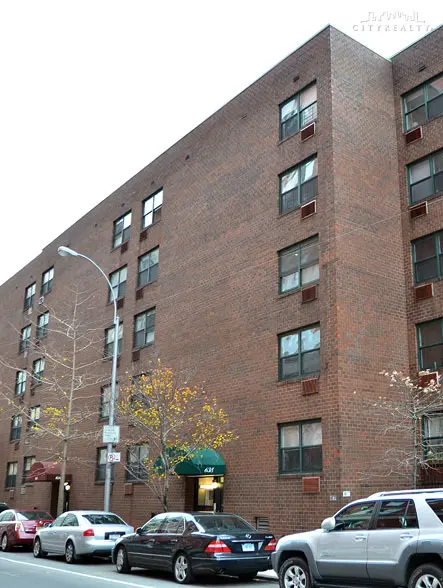638 Washington Street: Review and Ratings
between Barrow Street & Christopher Street View Full Building Profile


This 5-story, red-brick building is one of 42 similar buildings, many with fire escapes, that comprise the controversial, 420-unit West Villages Houses development in the West Village.
"Few strategic victories have been memorialized in such an unprepossessing, undecorated fashion as Jane Jacobs's vanquishing of Robert Moses's effort to alter the makeup of Greenwich Village in the 1960s," Julia Vitullo-Martin wrote in an article in the August 30, 2007 edition of The New York Sun.
The "stubby" West Village Houses were built in place of the towers the Wagner administration had preferred and are "a living testimony to that victory by Jacobs and her fellow New Yorkers," she wrote, adding that "without great arches or heroic statuary, the houses are plain brick buildings punctured by small windows, topped by flat roofs, and unadorned by anything other than an occasional window box of flowers."
"Conceived in idealism, their construction fell prey to a decade of delays and escalating construction costs that ate away at the architectural standards Jacobs had first proposed. By the time they opened in 1974, the houses were reviled by Jacobs as well as by most architectural critics, despite having been designed by the distinguished architectural firm of Perkins and Will. Indeed, the New York Times once called the houses "an unloved failure," the article said.
"Jacobs had just published her masterpiece inspired by the Village, 'The Death and Life of Great American Cities,'" the article continued, "when she faced down the Wagner administration and the City Planning Commission in the winter of 1961 over their plan to raze some 14 blocks of 19th-century warehouses and brownstones bounded by 11th Street on the north, Hudson, Washington, and Christopher streets on the east, Morton Street on the south, and West Street on the west."
"The city housing authority commissioner, Ira Robbins, called Jacobs and her allies 'ignorant, neurotic, dishonest, slanderous, disorderly, and disgusting.' Or, as writer Roger Starr, then executive director of the Citizens' Housing and Planning Council, said with more decorum: 'What a dear sweet character she isn't,'" the article continued.
"Jacobs, who lived with her husband and two children above a candy store at 555 Hudson St., a busy thoroughfare, believed in high-density, energetic neighborhoods. She had famously written, 'The stretch of Hudson Street where I live is each day the scene of an intricate sidewalk ballet.' But she loathed the modernist towers that were then the government's preferred architecture for low-income housing. First she stopped the destruction of her neighborhood, and then she stopped the construction of the towers that were still planned for the fringes of what had been an industrial, waterfront area. Instead, she urged the city to build low-rise vernacular architecture for moderate-income households. But this was easier said than done. The government knew how to build public housing for poor people and knew how to facilitate market-rate housing for upper-income households, but vernacular housing for the working class wasn't on any government's policy agenda. Worse, Jacobs didn't understand the level of subsidy that was going to be needed, noted planner Alexander Garvin, who as a city official in the early 1970s helped put together the development's financing. Far from public transportation and situated in what was then the grim outer fringes of the Village, the project just wasn't marketable as built. In late 1971, Mr. Garvin was called in by his superior, Donald Elliott, the city planning chairman, and instructed to arrange a capital subsidy for the project. The city had to go it alone because the project's lack of elevators made it ineligible for a federal mortgage," the article said.
"All accounts of West Village Houses end up with Jacobs being victorious," Mr. Garvin said, citing a 1999 Ken Burns documentary, "New York." "But every single mayoral administration since then has had to live with the errors of this development. This doesn't mean she wasn't right about neighborhood scale. But what she was recommending wasn't financially feasible from the beginning."
Indeed, the article said, "subsidies have continued through the Bloomberg administration. When the owner of the West Village Houses, the Island Capital Group, signaled in 2002 that it might choose to buy out of the Mitchell-Lama program, a delegation of tenants headed to the city's housing agency. (Under the terms of the state statute, owners may buy out of Mitchell-Lama after 20 years by paying off any government mortgages. They may then take apartments to market rents.) Without further government help, tenant rents almost surely would have skyrocketed by going to market rate."
"Working with both landlord and tenants, the Bloomberg administration devised a tenant-sponsored, non-eviction co-op conversion plan that allowed tenants who didn't wish to buy to remain in their apartments at protected rents. The plan went into effect on March 9, 2006. The city forgave a portion of the debt it held - about $19 million in accrued interest - and deferred a principal mortgage of $12 million, interest-free for 30 years. Property taxes were frozen for 12 years. An internal subsidy plan was established, funded in part by a 25% flip tax. The individual co-op owners are subject to ongoing income certifications: The annual income of a family of four, for example, cannot exceed $116,800. The apartments were priced by shares, managing agent Gail Davis said, with consideration given to size, location, view, and exposure, as well as how many floors had to be negotiated in the elevator-less buildings. A one-bedroom apartment on West Street, for example, was allocated 370 shares at $413 a share, yielding an initial sales price of $152, 810. A three-bedroom on a higher floor was allocated 648 shares for a price of $267,614. Residents had 90 days to buy at the insider prices. Each year the plan calls for an 11% increase in the restricted sales price on March 9, the co-op's anniversary. Today apartments sell at $536 a share, Ms. Davis said. But all apartments must first be offered to the corporation at the insider price. Only if the corporation declines to sell can the co-op owner seek outside buyers - who must then in turn meet the income limitations. An indication of the apartment's true market value can be found in the units retained by the original investors, who have listed a one-bedroom for $695,000 and a three-bedroom duplex for $1.75 million," the article said.
The complex was described by Elliot Willensky and Norval White in their book, "The A. I. A. Guide to New York City Architecture, Fourth Edition" (Three Rivers Press, 2000), as "The scene of the great war between the defenders of 'Greenwich Village scale' and the Establishment, which proposed another high-rise housing project." "The David in this case was Jane Jacobs, the Goliath, Robert Moses, the city's urban renewal czar. A pyrrhic victory for David: the 5- and 6-story red brick products are dumpy, dull, and for their time, expensive. Scale simply isn't enough!" the authors maintained.
In a May 15, 2005 article in The New York Times, Josh Barbanel described the development, which contains numerous gardens, as "once the ugly duckling of Greenwich Village."
Its location, however, has changed radically and is now one of the most desirable in the city as a result of the building of Hudson River Park nearby and the booming redevelopment in recent years of the Far West Village and Chelsea neighborhoods.
The complex was acquired in 1976 as a Mitchell-Lama rental development and the current owners, Island Capital Group, which is headed by Andrew Farkas, the former chairman of the Insignia Financial Group, announced plans in 2002 to leave that program and the following year a tenants association filed a lawsuit that sent a dispute over whether the apartments would be eligible for rent stabilization to the state's Division of Housing and Community.
Under the terms of an agreement announced May 20, 2004 by Mayor Bloomberg, however, the lawsuit was dropped and the association was allowed to form an affordable, non-eviction co-op. The agreement was also intended to keep rents below market rates for residents who do not buy into the co-op and the Bloomberg administration said it would ask the City Council to approve a tax exemption for the development that will maintain its tax abatement at the current level for 12 years. The agreement required that more than half of the tenants buy into the co-op.
The city agreed to forgive about $19 million of interest charges that has accrued on the mortgage and the owner agreed to sell the development to the tenants at a discount. The tenants association agreed to let the owner buy the units not bought by tenants and sell up to 51 of them at market prices without flip taxes or limits on prices.
The "Red Herring" dated February 28, 2005 indicated that 1,200,000 shares would be allocated to the 418 apartments for sale for $82,596,000.
By the end of February more than 60 percent of the eligible renters had elected to buy shares in the cooperative and the deal was closed. Under the terms of the deal, almost 100 residents will be offered new leases under rent stabilization by the old owners, who retain ownership of those units and rents start at the existing rate under the Mitchell-Lama program and future increases are established by the Rent Stabilization Board. The renters will remain stabilized for 12 years and can still purchase their units albeit at lesser discounts.





 6sqft delivers the latest on real estate, architecture, and design, straight from New York City.
6sqft delivers the latest on real estate, architecture, and design, straight from New York City.
